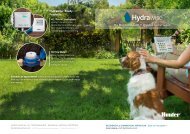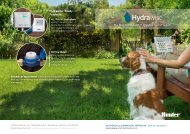Hunter Residential Sprinkler System / Irrigation system design guide - Calgary irrigation
Residential Irrigation Service and Design Guide for underground sprinklers. Learn how to design, install, service, repair and winterize your underground sprinkler system. Irrigation Calgary. Lawn irrigation. Underground sprinklers Calgary
Residential Irrigation Service and Design Guide for underground sprinklers. Learn how to design, install, service, repair and winterize your underground sprinkler system. Irrigation Calgary. Lawn irrigation. Underground sprinklers Calgary
You also want an ePaper? Increase the reach of your titles
YUMPU automatically turns print PDFs into web optimized ePapers that Google loves.
SYSTEM INSTALLATION<br />
Making the Point of Connection<br />
1. Refer to the Point of Connection (P.O.C.) detail on the<br />
<strong>Residential</strong> <strong>System</strong> Overview. See pages 12 to 13.<br />
2. Turn off the water supply to the residence.<br />
3. Dig a hole to expose the supply line.<br />
4. Cut an appropriate piece out of the supply line, slip<br />
the compression tee onto the pipe, and tighten the<br />
compression nuts.<br />
5. Install the brass nipple and shut-off valve.<br />
6. Install the valve box for easy access to the shut-off valve.<br />
7. Turn the water back on to the residence.<br />
Installing the Main Line<br />
Figure 1<br />
1. Using marking spray paint and small flags, indicate the<br />
pipe lines from the P.O.C. to the valve manifold locations.<br />
Mark the layout of the <strong>irrigation</strong> <strong>system</strong> Figure 1.<br />
2. On existing lawns, lay down a plastic tarp alongside the<br />
marked trench about 60 cm away from where the pipe<br />
will be placed.<br />
3. Remove the sod by cutting a strip about 30 cm wide and<br />
4 cm to 5 cm deep using a flat shovel. Roll up the sod and<br />
place the sod and dirt on the plastic tarp.<br />
4. Trenching: Check local codes. If there are no established<br />
local codes for sprinkler main line depth in your area,<br />
trench 25 cm to 30 cm deep. Trench 15 to 20 cm for<br />
lateral lines. Trenching can be done by hand or with a<br />
trencher. Trenchers are available at most equipment<br />
rental yards Figure 2.<br />
5. Installing Pipe Under a Walkway or Driveway:<br />
Jetting Method — Using a pipe-to-hose threaded<br />
adapter, connect one end of the pipe to a garden hose<br />
and attach a small stream hose nozzle to the other end.<br />
Turn the water on and jet under the concrete Figure 3.<br />
Figure 2<br />
6. Install the backflow preventer according to local codes.<br />
7. Installing Pipe: Lay out pipe and fittings near the<br />
trenches according to how they will be installed. Be<br />
careful not to get dirt or debris in the pipe.<br />
8. Beginning with the P.O.C. (or backflow preventer if<br />
applicable), measure, cut, and install the pipe,<br />
working your way to the last manifold or stub-out.<br />
See <strong>Residential</strong> <strong>System</strong> Overview on pages 12 to 13.<br />
Figure 3<br />
RESIDENTIAL SPRINKLER SYSTEM Design Guide<br />
15





